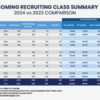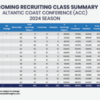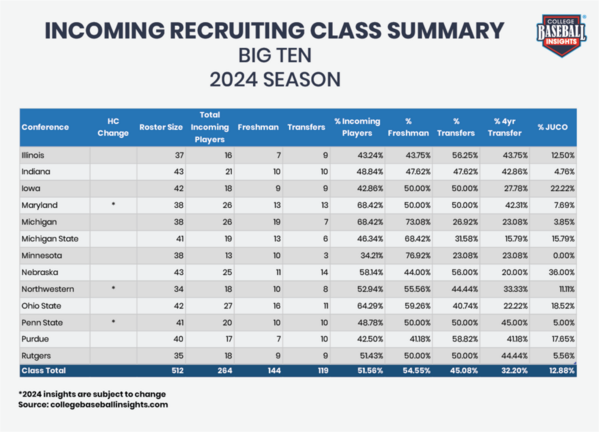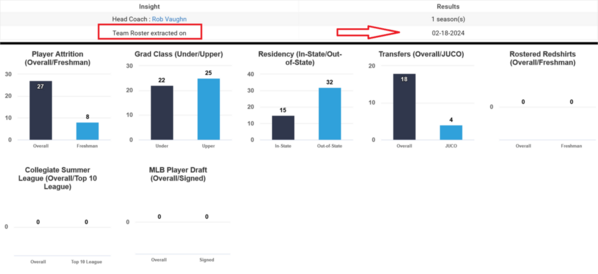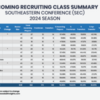Replies sorted oldest to newest
Attachments
Attachments
Attachments
Attachments
Thanks for all this data, CBI, that's illuminating. A couple of questions:
- some teams list roster sizes over 40. Are these fall rosters? Spring rosters?
- most teams have incoming classes that are more than half the size of the total roster. So that means that half of a roster is leaving each year? That's pretty astonishing.
@anotherparent posted:Thanks for all this data, CBI, that's illuminating. A couple of questions:
- some teams list roster sizes over 40. Are these fall rosters? Spring rosters?
- most teams have incoming classes that are more than half the size of the total roster. So that means that half of a roster is leaving each year? That's pretty astonishing.
@anotherparent These are spring rosters, we record extraction date.
Attachments
Attachments
But then how are there rosters with 45-47 players?
For the summaries, is that based on spring rosters? If so, it doesn't seem as dire as some make it out to be. Few schools have more transfers than freshmen coming in.
@anotherparent posted:But then how are there rosters with 45-47 players?
I would say, simply excess of 40 will be redshirted. On development team (non documented), etc.
@nycdad posted:For the summaries, is that based on spring rosters? If so, it doesn't seem as dire as some make it out to be. Few schools have more transfers than freshmen coming in.
All information was derived from Team Roster Turnover Insights
There are no official NCAA rules regarding how teams display their rosters on their athletic department websites.
In some cases, it could possibly be because a player suffered a season-ending injury before the season started (and can therefore be replaced), but the coaching staff still wants to acknowledge them as a continuing member of the team.
Those are the only explanations I can provide for why some D1 teams list more than 40 guys on their baseball roster.
So I have no expertise at all other than observation, but I think that the following apply:
- a student with a scholarship MUST be listed on the roster. If he doesn't get in any games, he is awarded a redshirt year after the end of the season.
- a student NOT on scholarship can be listed on a roster and not play. But if he is told ahead of time that he is being "redshirted" then he might not be listed on the roster. In that case, he is just a student, who cannot practice with the team. I've seen this happen with kids I know.
Don't know how these things apply to injuries.
An incoming fall D1 roster is not the official roster until the final roster is set before the championship season begins. The NCAA max for baseball may include redshirt players not necessarily on scholarship. There may be differences in conference rules.
Don't forget there are limits on the # of counters as well.
I would suggest privately contacting Rick for his advice.
@TPM posted:An incoming fall D1 roster is not the official roster until the final roster is set before the championship season begins. The NCAA max for baseball may include redshirt players not necessarily on scholarship. There may be differences in conference rules.
Don't forget there are limits on the # of counters as well.
I would suggest privately contacting Rick for his advice.
@TPM KISS, information provided is based on who is listed on the roster when the season starts.
As student athletes and families perform their necessary research, looking at the roster at the time of the championship season provides a false impression as to true number of players that were in the program.
@CollegebaseballInsights posted:@TPM KISS, information provided is based on who is listed on the roster when the season starts.
As student athletes and families perform their necessary research, looking at the roster at the time of the championship season provides a false impression as to true number of players that were in the program.
Way ahead of myself. My bad. Season rosters are listed when regular season begins. There I fixed it.
BTW, where are all of the other P5 programs?
Well the obvious thing to do is to look at actual rosters. So I had a look at Mississippi State, which CBI's data has 47. Today they list 45.
Obviously a roster doesn't say things like "redshirting".
@anotherparent posted:Well the obvious thing to do is to look at actual rosters. So I had a look at Mississippi State, which CBI's data has 47. Today they list 45.
Obviously a roster doesn't say things like "redshirting".
@anotherparent again the better number is 47 because it provides a clear indication how many players were part of the program at the start of the season.
Here is why, in 2016 Coastal Carolina started with 35 players, by the end of the year their website had 29.
We knew 2 of the players not listed, 1 played against my son, left the team, the 2nd had TJ Surgery, played with my son at a JUCO in 2017.
If a student athlete and parent looked at their website in June, they might assume the team carried 29 players for the entire year.
Thus looking at the school's website is a point in time that doesn't show a teams actual roster management, especially related to students leaving teams to entire the transfer portal.
Note, we've have seen many cases whereas a the school will remove a player that has stats.
Again, that provide false roster insights as to how many players actually participated on the team at a certain point in time.
@TPM posted:Way ahead of myself. My bad. Season rosters are listed when regular season begins. There I fixed it.
BTW, where are all of the other P5 programs?
If you scroll up, there are infographs for ACC, BIG-12, BIGTEN, PAC-12 and SEC
@anotherparent posted:Well the obvious thing to do is to look at actual rosters. So I had a look at Mississippi State, which CBI's data has 47. Today they list 45.
Obviously a roster doesn't say things like "redshirting".
@anotherparent schools manage their websites various ways. With respects to "redshirting" it is not consistent, but we've figured out a way to tag based on certain situations. Normally there is a year's lag on tag historical records.
Re: CBI's comments about Transfer Portal. As I'm sure many on this board are aware, perhaps with their own kids, many schools will remove a player from the roster once they inform their school that they are entering the Transfer Portal.
It's something I think is silly and petty, but it happens all the time.
@Rick at Informed Athlete posted:Re: CBI's comments about Transfer Portal. As I'm sure many on this board are aware, perhaps with their own kids, many schools will remove a player from the roster once they inform their school that they are entering the Transfer Portal.
It's something I think is silly and petty, but it happens all the time.
@Rick at Informed Athlete And there lies the challenge of looking at school's roster to determine what is the college roster management strategy for a particular season. We perform 2 to 3 data capture events per year. We don't delete, but mark where appropriate. This allows the researcher to review and come up with their own set of questions concerning their target schools.
@CollegebaseballInsights posted:If you scroll up, there are infographs for ACC, BIG-12, BIGTEN, PAC-12 and SEC
That's only 5.
@TPM posted:That's only 5.
What's the title of this post?
I know of kids at P5 schools, who are getting money and red-shirted who ARE NOT on the published rosters.
@TPM posted:That's only 5.
If I'm mistaken, you asked the same question last year.
@CollegebaseballInsights posted:If I'm mistaken, you asked the same question last year.
You are right.I was thinking of something else.
How about posting another conference outside of the P5 programs?
@TPM posted:You are right.I was thinking of something else.
How about posting another conference outside of the P5 programs?
At this point in time, not in the scope of work. Information can be easily be obtained
@Master P posted:I know of kids at P5 schools, who are getting money and red-shirted who ARE NOT on the published rosters.
That can be true.
The NCAA does not make this easy to find! By definition, a "counter" is a player who is receiving an athletic scholarship, in the case of baseball a minimum of 25%. This year a team can have a maximum of 40 players, and a maximum of 32 counters.
A team does not have to give out all its allowed 11.7 scholarships. And it can have many players on the roster who are not getting athletic scholarships at all.
So I guess I can see how you could have a counter who was not on the roster. It would mean that more players on the roster were not on athletic scholarship. Kind of a waste of the coach's/school's money, but I guess NIL collectives at some places are making that less relevant anyway.
Or am I missing something?
I have no personal axe to grind here, I just find the whole thing fascinating.
@anotherparent posted:The NCAA does not make this easy to find! By definition, a "counter" is a player who is receiving an athletic scholarship, in the case of baseball a minimum of 25%. This year a team can have a maximum of 40 players, and a maximum of 32 counters.
A team does not have to give out all its allowed 11.7 scholarships. And it can have many players on the roster who are not getting athletic scholarships at all.
So I guess I can see how you could have a counter who was not on the roster. It would mean that more players on the roster were not on athletic scholarship. Kind of a waste of the coach's/school's money, but I guess NIL collectives at some places are making that less relevant anyway.
Or am I missing something?
I have no personal axe to grind here, I just find the whole thing fascinating.
This thread is going down a rabbit hole. The objective of this post is very simple, "To understand where P5 schools sourced their players, It is not an all or nothing Transfer portal"
As for roster sizes or how many student athletes are at the school, either rostered or non-rostered, when researching target schools, you might not get a true picture of the numbers.
We have seen over the past 10 years that show data integrity issues with respects to roster data, missing, deleted, incorrect, etc.
CBI data management approach is to capture and not physically delete records
Through data quality control initiative, we've tried to reconstruct and fill in gaps where applicable.
This allows us to create some more advance insights:
Well, I don't think it's a rabbit hole. The sourcing of players matters of course, but in the context of other factors.
It used to be said on this site all the time that an athletic scholarship at a D1 was a guarantee that you would be on the roster freshman year, whereas accepting a walk-on was a much bigger risk. Keeping in mind, of course, that coaches could run off scholarship players too, in various ways, if they wanted to do that.
Now with larger rosters, constant transfers, and NIL, the landscape seems very different. If kids with athletic scholarships are not being put on the roster, that's something else for people to try to figure out.
@anotherparent posted:Well, I don't think it's a rabbit hole. The sourcing of players matters of course, but in the context of other factors.
It used to be said on this site all the time that an athletic scholarship at a D1 was a guarantee that you would be on the roster freshman year, whereas accepting a walk-on was a much bigger risk. Keeping in mind, of course, that coaches could run off scholarship players too, in various ways, if they wanted to do that.
Now with larger rosters, constant transfers, and NIL, the landscape seems very different. If kids with athletic scholarships are not being put on the roster, that's something else for people to try to figure out.
IMHO, as stated in my previous response, it is a rabbit hole for this particular thread.
This is simple roster management, how schools are sourcing, etc. How schools document their rosters do not always align with NCAA Rules.
College Baseball Insights is based on data, thus trying to provide a more accurate picture of the landscape.
So what show a student athlete believe the rule, the schools website or CBI?
It is a choice.


